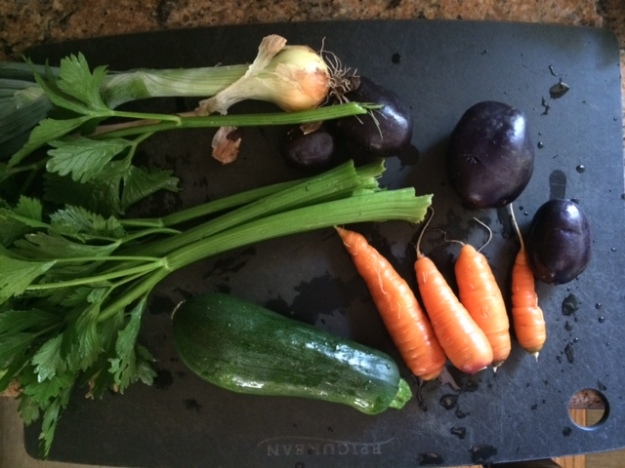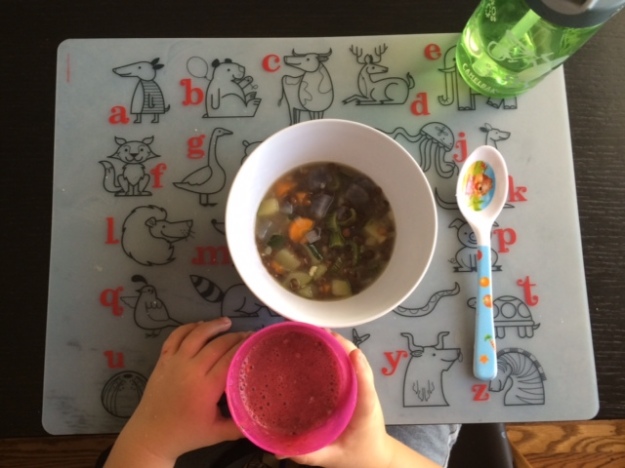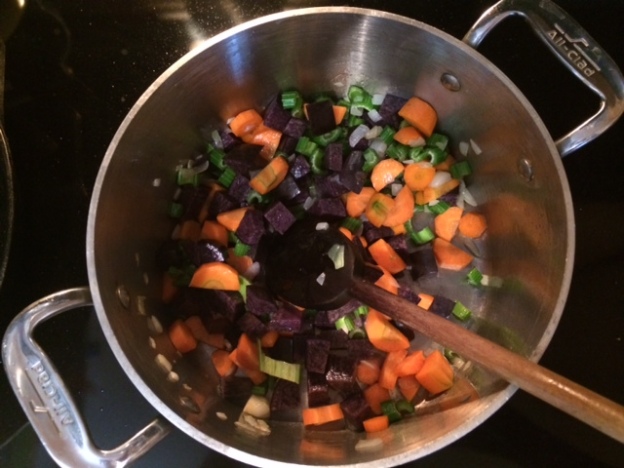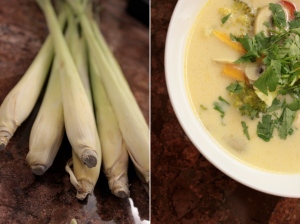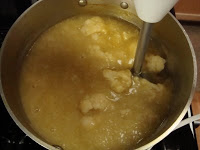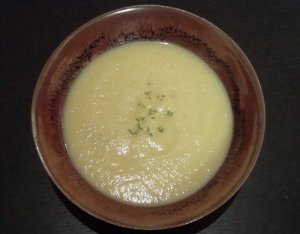
Before I jump into the foodie aspect of this dinner, let me preface with a little bit of background information. I learned about the Paleo Diet earlier this year from a friend and neighbor, Richard, who has experienced impressive weight loss and fitness success by revamping the way he thinks about food and eating. Richard writes a blog about his paleo lifestyle at http://freetheanimal.com/, which includes a nice balance of information from recently published research & position papers and personal experience in the form of recipes, progress photos, and emails from friends and family who’ve also experienced positive results.
For a complete overview of what paleo eating entails you really should check out Richard’s blog (nice overviews here & here), but I will do my best to give you a quick rundown. The basic premise is that, in the grand scheme of evolution, the amount of time that we’ve been agricultural people is about 2 seconds (approximation mine). This means that for the majority of human history, our ancestors have been hunters and gatherers. Things like grains, vegetable oils and processed sugars haven’t been available to us, and therefore we are not as well adapted to eating them. A paleo meal (also called “primitive”) usually consists of meat, vegetables, and some fruit (mostly fruits that would typically be gathered, like berries).
I know this sounds a lot like Atkins, but the focus is on eating real, unprocessed food, without counting carbs (or counting anything, for that matter). I find this all very interesting, especially given Richard’s results, and those of our good friends Kevin & Joseph after going paleo.
Recently, Richard has given me several flattering plugs on Free the Animal. Apparently, I’ve inspired him to focus more on food presentation and photography on his “food porn” posts (and his hard work is paying off, because the food looks great!). We decided to get together for dinner after our trip to France, and I knew that I wanted to cook Richard and his wife Bea a paleo dinner so that I’d be able to feature Free the Animal here.
Deciding on a menu took all week and a bit of research. I changed my mind several times, including the day before our dinner, when the beef I’d planned on making didn’t look as enticing as a beautiful fillet of halibut. But that’s how I decide what’s for dinner- pick what looks good at the farmer’s market/grocery store that day- so I’m used to last minute changes. Here’s what I ended up deciding on:
Chilled Tomato Soup with Basil-Infused Oil
~
Broiled Halibut Fillet with Parsley Lemon Butter
served with Pipérade
~
Paleo Raspberry Tart with Raw Whipped Cream
I was pleased with the results, and guessing from the reaction I received from Richard, Bea & Trevor, so were they. Below I’ll break down each component of the menu and provide recipes for your viewing (and perhaps testing/tasting pleasure).
Parsley Lemon Butter

Ingredients:
2 pints heavy whipping cream
3 tbsp creme fraiche
2 tsp cheese salt (optional)
1 cup parsley (washed & packed)
2-3 tbsp lemon juice
zest from 1 lemon
Directions:
- For the cultured butter: Pour the cream into a clean, earthenware bowl. Add the creme fraiche and gently mix with a clean whisk. Allow the cream to sit overnight in a warm room (about 75 degrees). The next morning, the cream should have thickened slightly. Pour it into the bowl of an electric mixer, fitted with a whisk attachment. Turn the mixer on low and allow the cream to mix until the solids (butter) separate from the liquids (buttermilk). (I didn’t take any pictures of this part, but I’ll make more butter soon and post pictures). Pour the buttermilk into a jar and save it for another use. Add ice water into the bowl with the butter and turn the mixer back on low. Pour out the water (don’t save this time, just dump it out), and continue to “wash the butter” until the water runs clear. Once the water is clear, use the back of a wooden spoon to mix the butter by hand, trying to press out as much water as possible. Pour excess water out of the bowl. If you want to salt the butter, add the cheese salt now and mix it in. Congratulations! You’ve made butter!
- Keep about half of the butter you’ve prepared for a different use. Put the other half in the bowl of a food processor (if you want to skip the whole “make your own butter step,” soften 1 cup of butter and use it as your base for parsley lemon butter).
- Add the parsley and lemon zest to the butter. Turn the food processor on. While it’s running, add lemon juice in 1/2 tbsp increments. I recommend stopping the food processor a few times as you’re adding lemon juice to taste the butter. You may like more or less acid.
- Transfer the parsley lemon butter to small ramekins, cover with wax paper and store in the refrigerator until you’re ready to use it. About an hour before you serve the butter, take it out of the fridge to soften.
Chilled Tomato Soup with Basil-Infused Oil
Part 1: Basil Oil
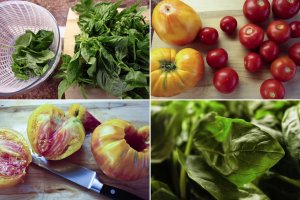
Ingredients:
2 cups basil (washed & packed)
1 cup olive oil
Directions:
- In a small pot, bring a few cups of water to boil. Toss basil into the boiling water for 15-30 seconds to blanch.
- Remove basil and pat dry with a paper towel. Coarsely chop basil.
- Place basil and olive oil in a food processor.
- Run food processor until basil is chopped and mixed with olive oil (this doesn’t take long, maybe 10-20 seconds).
- Transfer oil to a small pot and heat over low heat for about 5 minutes.
- Remove from stove and allow to cool for about an hour.
- Place a piece of cheesecloth over a strainer. Strain basil leaves from oil and transfer resulting basil-infused oil to a jar or condiment bottle for storage.
- Store oil in refrigerator until ready for needed.
Part 2: Chilled Tomato Soup (recipe from Alice Waters: Vegetables…one of my very favorite cookbooks!)

Ingredients:
4 pounds ripe tomatoes
2 tbsp salt
1 small cucumber (peeled, seeded and finely chopped)
2 stalks celery (finely chopped)
3 shallots (finely chopped)
White wine vinegar (I used red wine vinegar)
Directions:
- Cut the tomatoes into quarters and toss with salt. Allow to sit and soften for about 30 minutes. While the tomatoes are softening, cover the shallots in vinegar and set aside.
- Once soft, mash the tomatoes with the back of a wooden spoon. Pass the tomatoes through a food mill to remove tomato skins (I used the largest setting of my food mill). You should obtain a thick tomato juice.
- Stir diced shallots, cucumber and celery into tomato juice. Add salt and vinegar to taste.
- Chill in the refrigerator until ready to serve.
- Now for my variation: Just before serving, top soup with basil-infused oil and a little sprig of basil.
Broiled Fillet of Halibut with Parsley Lemon Butter, served with Pipérade

Part 1: Pipérade
Ingredients:
1 yellow onion (chopped)
2 green bell peppers (seeded, halved and sliced)
1 red bell pepper (seeded, halved and sliced)
1 orange bell pepper (seeded, halved and sliced)
6-8 sliced prosciutto (coarsely chopped)
8 medium tomatoes (peeled, seeded and coarsely diced)
Butter & Olive oil for pan
Salt, pepper and herbes de provence, to taste
Directions:
- Heat a medium dutch oven over medium-low heat. Add prosciutto and cook for 2-3 minutes, until lightly browned. Remove prosciutto and set aside. Melt butter and/or olive oil. Add onions and slowly cook for 8-10 minutes.
- Add bell peppers and seasoning. Allow to slowly cook for another 10-15 minutes.
- Add tomatoes and cook for 5 minutes.
- Just before serving, put prosciutto back into pipérade.
- Serve alongside halibut. Leftovers are wonderful and are traditionally served with an egg or two, sunny side up.
Part 2: Broiled Fillet of Halibut with Parsley Lemon Butter
Ingredients:
1 fillet of halibut
parsley lemon butter
1 shallot (finely chopped)
1/2 cup fresh parsley (coarsely chopped)
Juice from 1 lemon
Salt & pepper to taste
Basil oil (or olive oil) to grease pan
Directions:
- Place tin foil on a large rimmed cookie sheet. Grease foil with basil oil (or olive oil).
- Carefully rinse and pat dry the halibut fillet. Place the fillet on the greased baking sheet.
- Place pats of parsley lemon butter on top of halibut. Sprinkle with salt, pepper, lemon juice, shallots and parsley.
- Turn your oven’s broiler on the low setting and place the halibut in the top 1/3 of the oven (no need to preheat, the broiler becomes hot fast).
- Broil the halibut for about 15 minutes (more or less depending on the size of the fillet…mine was about 2.5 pounds).
- Remove from oven and serve with parsley lemon butter and pipérade.
Paleo Raspberry Tart with Raw Whipped Cream

Ingredients:
For paleo pastry crust:
3/4 cup dates (pitted and coarsely chopped)
3/4 cup coconut flour
3/4 cup almond meal
1 stick cold butter, diced
1/4 cup very cold water
For paleo raspberry jam (no sugar!):
12 oz frozen, unsweetened raspberries
1/4 cup honey
7-8 lemon seeds
For topping:
Raspberries
Raw cream
Directions:
- For paleo pastry tart: Preheat oven to 375 degrees. Add first 4 ingredients to the bowl of a food processor. Turn food processor on and slowly pour in cold water. The dough should come together, although it will be nearly impossible to roll out. Instead press the dough into a buttered tart pan. Bake in preheated oven for 15 minutes (but I recommend checking after 10 minutes, because the almond meal will have a tendency to burn if it bakes too long). Allow the crust to cool completely before using.
- For paleo jam: Cut a small square of cheesecloth and a small piece of kitchen twine. In the center of the cheesecloth, place your lemon seeds. Then use the kitchen twine to tie the cheesecloth into a small bundle.* In a small pot, add the raspberries, honey and lemon seed bundle. Cook over medium-low heat for 15-20 minutes. You can test whether the jam is starting to come together by spooning a small amount onto a clean plate. The jam should move slowly when the plate is tipped to one side or the other. If you prefer less seeds in your jam, pass the jam through a food mill on the medium setting. Allow the jam to cool completely before using.
- For the topping: Top crust with an even layer of raspberry jam. Then top with raspberries. If desired, whip up some homemade whipped cream in a stand mixer fitted with a whisk attachment, to make for a more decadent dessert. I used raw cream to keep the meal the least processed possible.
* Wondering what the lemon seeds are for? Lemons and apples are “high pectin” fruits and can be used when making jam to add a little natural fruit pectin boost. These methods have been used for jam-making for many years, in the days before you could buy nifty little boxes of pectin from the grocery store. For more info check here, or google it!
